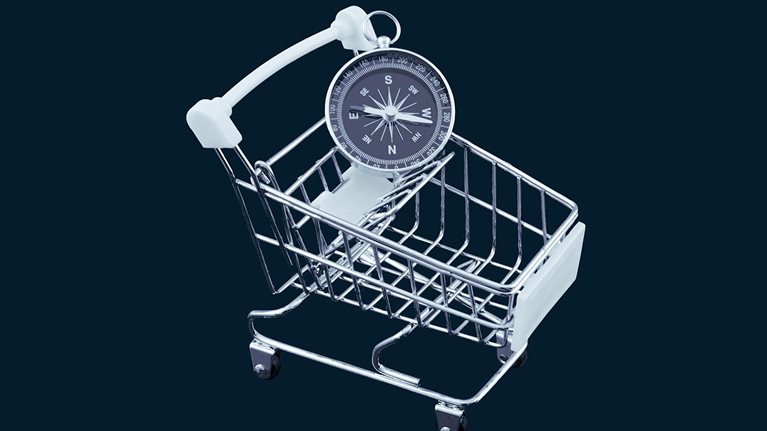Most apparel companies have participated in e-commerce for almost two decades, and online sales represented 35 percent of apparel sales in 2019. Many retailers have adopted an “omnipresent” model in which product and inspiration are always available. Mobile and digital technology has enabled location-specific offers and product availability. The customer is winning, but can a retailer’s supply chain keep up?
Going digital has required retailers to offer speedy delivery options for customers who increasingly demand faster delivery of their purchases. In a recent McKinsey customer survey,1 more than 50 percent of customers surveyed expect their apparel orders to arrive within two or three days of purchase. Moreover, e-commerce is evolving from a self-service model to a full-service model. This may be great for customers, but it often proves expensive and capital-intensive for retailers.
Retailers need a new operating model to break the cycle of selling more at lower margins. American Eagle Outfitters (AEO) is executing an aggressive strategy to overcome this hurdle in the race to successful digitization. The company is reinventing its supply chain by pulling inventory from its stores and reducing in-store fulfillment. The strategy may sound counterintuitive given the direction most retailers have been heading. Insightfully, the company realized that it creates the ability to tap into dynamic demand, increases flexibility and efficiency, and minimizes friction, meeting customers where and how they want to be met.
We sat down with Shekar Natarajan, head of global inventory, supply chain, and logistics at AEO, to see how the company has accomplished this paradigm shift in thinking and operations.
Would you like to learn more about our Retail Practice?
McKinsey: How did you envision your recent “supply chain of the future” evolution?
AEO: Heading into 2019, we saw the retail industry on the verge of significant, fundamental change, reflected in evolving customer needs, rising delivery expenses, and growing labor-market expectations. We recognized that our distribution center capacity was challenged, especially during peak weeks. We took some steps to expand capacity. We added extra racking, introduced automation, and used stores as fulfillment centers. All this had some impact, but we knew the costs of this extended capacity would never scale. We had done a great job keeping up with the times, but we wanted to augment our supply chain to handle changing customer needs—not just keep up but continue to lead the industry.
McKinsey: Many retailers accelerated their plans during COVID-19 but became more conservative with inventory. What did you do?
AEO: COVID-19 has accelerated the shift to digital shopping by three to five years. Logistics disruption and cracks in the supply line have surfaced, and capacity constraints for air, ocean, and delivery agents have been completely upended. These challenges aren’t going away.
We already had a blueprint for addressing the challenges, which helped us turn this crisis into an opportunity. We completely diversified our operations and reconfigured our network in just four months. We stood up four fulfillment locations across the country, each handling 5–10 percent of our e-commerce volume and replenishing 100–150 retail stores. These facilities let us pull inventory upstream and reduce our reliance on stores for fulfillment—down from 17 percent of shipments to just 4 percent. We set up a national reverse-logistics hub to manage all e-commerce returns, which really relieved the burden on our distribution centers.
We also introduced redundancy into our delivery network by onboarding regional carriers. By diverting more than 20 percent of our volume to these new partners, we gained slack capacity to tap into when needed—at lower overall cost—while increasing our speed to the customer.

McKinsey: Nobody in the apparel sector has implemented a model like this due to the unpredictability of new items. Why did you think this would work?
AEO: We thought that driving the highest inventory productivity and cutting our cash-to-cash cycle times would require moving more inventory upstream—especially our fast-fashion items—and building an infrastructure that could capture the true demand signal.
At AEO, we love to solve complex problems. So, faced with this challenge, we reviewed our assortment, dissected the problem, and decided to take a fresh approach. We created very scientific, intelligent algorithms to identify what assortment to put where and send inventory to the right locations in our multitier network. We built advanced models and systems to manage inventory transfers and overlaid them on our inventory-planning systems.
McKinsey: What have you learned about inventory from deploying this model?
AEO: We learned that our assumptions were right. Deploying this model let us validate the two ultimate drivers of inventory performance and productivity—flexibility in flow and speed in response. Getting the right inventory in the right place at the right time may sound like a cliché, but we proved our theory that consolidating inventory upstream and delaying decision making helped us better translate true demand signals into a fast, dynamic, and efficient network.
Our business model is omnichannel, meaning that we have to be close to both the end customer and our store network. Our in-market fulfillment facilities meet both needs very well. We can respond quickly to the customer and quickly replenish our stores as inventory gets sold. We’ve reduced our in-store inventory 23 percent (from four weeks of coverage to one week), while still meeting sales demand. Our infrastructure can service 95 percent of the fleet within two days—from allocation to in-store.
McKinsey: What had to change internally for you to implement this model?
AEO: Even though we had sophisticated tools, capabilities, and thinking, we still had to make a lot of changes, as most retailers would. We needed to try new things: break paradigms; understand the real drivers of inventory, cash, and sales performance; and act on all those learnings. Turbocharging our operations almost felt like flying a plane and building a new engine while in the air.
The most important moves we made were in how we allocate and deploy inventory, how fast we read sell-through and demand (hourly versus weekly), and what system changes we needed to manage complete e-commerce shipments, faster handling times, and more frequent (daily) deliveries to our stores. We had to integrate our supply chain operations with inventory management. We had to bring scientific rigor to everything we looked at, apply a start-up mentality to our operations, and make process excellence part of our everyday culture.

We saw the looming needs clearly. We just had to prepare with focus and urgency to handle whatever challenges emerged—while working remotely, of course. Having passionate associates who believed in the vision and worked tirelessly to make it happen went a long way toward simplifying the complexities and making the transition fast, focused, and rewarding.
The courageous moves we made as an enterprise, coupled with our supply chain transformation, produced a 400 percent growth in our stock valuation. We’re collectively proud to deliver these results during a raging pandemic with so much uncertainty around labor, global logistics disruption, e-commerce acceleration, and unstable operating conditions.
McKinsey: What has the impact on your business been?
AEO: We’ve seen tremendous impact. Our total markdowns dropped more than 25 percent, compared with 2019, even as e-commerce grew more than 30 percent during that time. The new supply chain structure helped us reduce network inventories and maintain digital delivery costs, compared with revenue.
Even during the busiest time of the year, we saw inventory productivity increase 600 basis points. We had the latest shipping cutoffs in the industry, allowing us to meet industry-best customer promise. Our customers just might be the biggest winners of all. Most received their orders within two days of shipping, even at the highest peak, while many of our peers struggled to keep up with fulfillment and shipping capacity needs.
As a supply chain team, we learned just how much we can deliver when we prioritize our performance and customer service goals. That’s the spirit we have to maintain as we continue to build a more flexible and productive supply chain.
Even the greatest ideas are just ideas if you cannot properly execute them. And it takes a village. At AEO, we’re extremely fortunate to have the support of Jay Schottenstein, our inspiring and visionary CEO, and Michael Rempell, our forward-looking COO. We’re lucky to be surrounded by a tenacious group of cross-functional partners who are always willing to join forces with us to solve big problems. Personally, I am immensely grateful to have such strong supply chain leadership teams ready, willing, and able to lead their teams through the toughest times.
The many ambitious targets ahead will require investments to enhance our brands and products as well as our digital and store experiences. As a supply chain team, we must and will be ready to deliver.

McKinsey: You are a futurist! How do you see the future evolving in this space?
AEO: Despite the challenges, it is the midsize retailers and mom-and-pop shops that truly embody the entrepreneurial spirit of who we are as a country and a society. They provide the essential diversity of choice, product options, and vibrancy in local communities. Lacking deep pockets, many of these retailers face seemingly insurmountable disruption in their value chains, driven by a number of forces, from carrier capacity to COVID-19.
We can create and offer a tech-enabled operations platform to help them. We have slack capacity in the market today, but helping smaller retailers tap into that unused capacity requires joining forces. Hyper-localization will be the key to meeting customer needs. We have to tap liquid labor pools, regional carriers who have excess capacity during some of their runs, and fulfillment center capacity to move goods quickly.
We will see a separation happen over time—between the successful and profitable brands and those who don’t make it. We feel this model is not only the way of the future, but it’s also the only way for small and medium-sized retailers to survive and thrive.
Partnering with others facing similar problems provides the scalability required for sustainable solutions. We have seen parallels in other industries, including music, data management and storage, digital content distribution, hotels, and ride-hailing. Now is the time to revolutionize global trade. In this new world, brands can focus on what they do best: product, brand-building, and experience development. The intersection of disruption and creation of the new normal is an exciting time and place for supply chain professionals. We believe in this environment and in our vision, and we have a dedicated team to bring it all to life.
Uncharted waters require a new model
The past year forced a lot of change on many apparel businesses, mostly to mitigate the uncertainty and shed costs. Some apparel players did not let the pandemic slow down plans to make their businesses more convenient, productive, and successful. American Eagle Outfitters implemented a new network model, Lululemon made a major acquisition, and Nike began fulfilling orders from its wholesale and DTC inventory. Similarly, new service providers like Returnly, CaaStle, Mirakl, and thredUP expanded their reach.
As we look ahead, the overall apparel market seems likely to recover slowly, but the winners will be those who can “bend the cost curve” in supply chain. They will focus their energy on capturing fragmented customer traffic while moving inventory and fulfilling orders efficiently and profitably.


